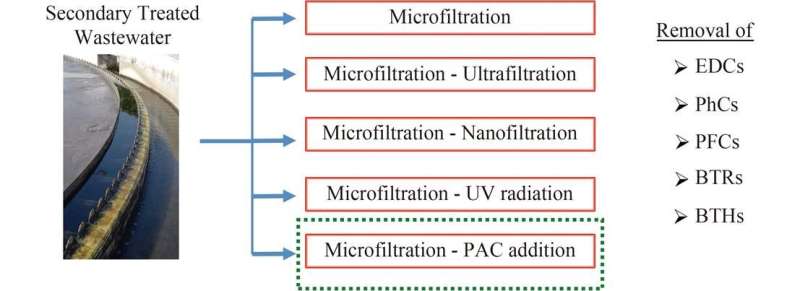First comprehensive assessment of effectiveness of tertiary treatment processes in removing emerging contaminants

Emerging contaminants (ECs) including pharmaceuticals (PhCs), endocrine disrupting chemicals (EDCs), benzotriazoles (BTRs), benzothiazoles (BTHs) and perfluorinated compounds (PFCs), pose a potential ecological threat when they are discharged into the aquatic environment. Therefore, there is an imperative need to adopt efficient and low-cost tertiary treatment processes for removing ECs, with no parallel formation of harmful by-products.
The ultraviolet (UV) disinfection, powdered activated carbon (PAC) adsorption and membranes are some of the most common physico-chemical tertiary treatment processes applied worldwide to improve the quality of treated wastewater effluent. As we all known, ECs belonging to different chemical classes co-exist in domestic wastewater forming chemical mixtures.
Adopting a tertiary treatment method that could significantly remove a large number of ECs, using conditions commonly applied in Sewage Treatment Plant (STP) to remove conventional pollutants, would be the optimal solution, achieving environmental protection goals without excessive increases in costs for the operation of the STPs.
With this background, Dr. Olga S. Arvaniti and Pro. Athanasios S. Stasinakis from University of the Aegean and their team members have worked jointly and investigated the effectiveness of microfiltration (MF), ultrafiltration (UF), nanofiltration (NF), UV radiation, and PAC adsorption to remove selected ECs from secondary clarifier effluents.
Their work examined the removal of 38 ECs (PFCs, BTRs, EDCs, BTH and PhCs) at environmentally relevant concentrations, which is the first comprehensive assessment of the common tertiary wastewater treatment process and relevant operating conditions for a wide range of EC classes. This study entitled "Effectiveness of tertiary treatment processes in removing different classes of emerging contaminants from domestic wastewater" is published in Frontiers of Environmental Science & Engineering.
In this work, 38 different ECs (PhCs, EDCs, BTRs, BTHs and PFCs) were initially identified and quantified in the biologically treated wastewater collected from Athens' (Greece) STP. Processes already used in existing STPs such as MF, NF, UF, UV radiation, and PAC were assessed for ECs' removal, under the conditions that represent their actual application for disinfection or advanced wastewater treatment.
The results indicated that MF removed only one out of the 38 ECs and hence it was selected as pretreatment step for the other processes. UV radiation in the studied conditions showed low to moderate removal for 5 out of the 38 ECs. NF showed better results than UF due to the smaller pore sizes of the filtration system.
However, this enhancement was observed mainly for 8 compounds originating from the classes of PhCs and PFCs, while the removal of EDCs was not statistically significant. Among the various studied technologies, PAC stands out due to its capability to sufficiently remove most ECs. In particular, removal rates higher than 70% were observed for 9 compounds, 22 were partially removed, while 7 demonstrated low removal rates.
This study investigated comprehensively and systematically the common tertiary wastewater treatment process and relevant operating conditions for a wide range of EC classes for the first time. In addition, this work provides a constructive suggestion that future research should focus on scaling-up PAC in actual conditions, combining PAC with other processes, and conduct a complete economic and environmental assessment of the treatment.
More information: Olga S. Arvaniti et al, Effectiveness of tertiary treatment processes in removing different classes of emerging contaminants from domestic wastewater, Frontiers of Environmental Science & Engineering (2022). DOI: 10.1007/s11783-022-1583-y
Provided by Higher Education Press




















